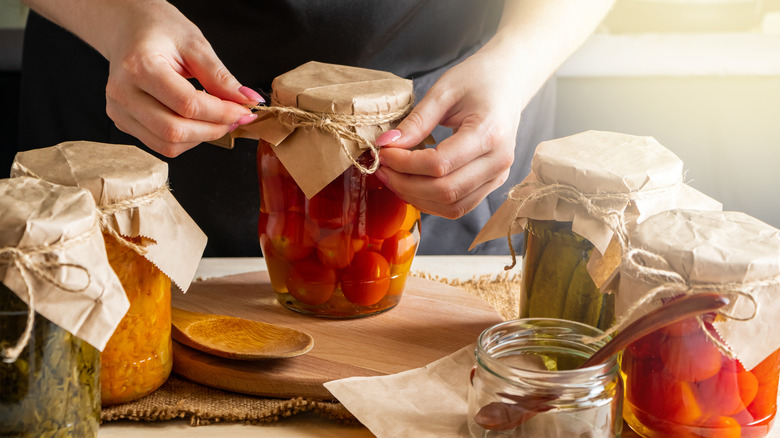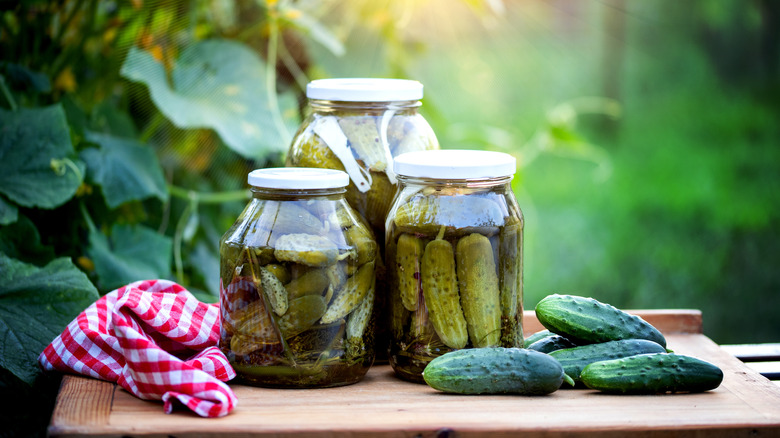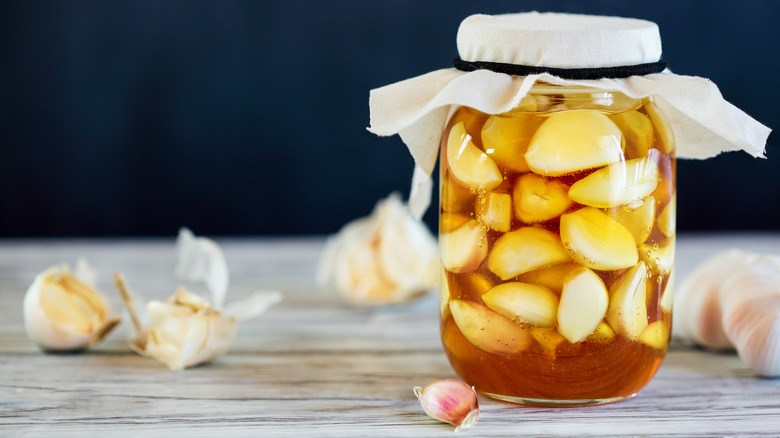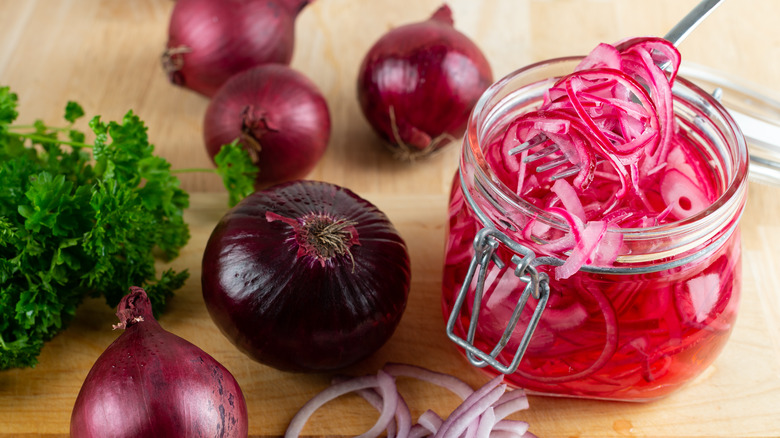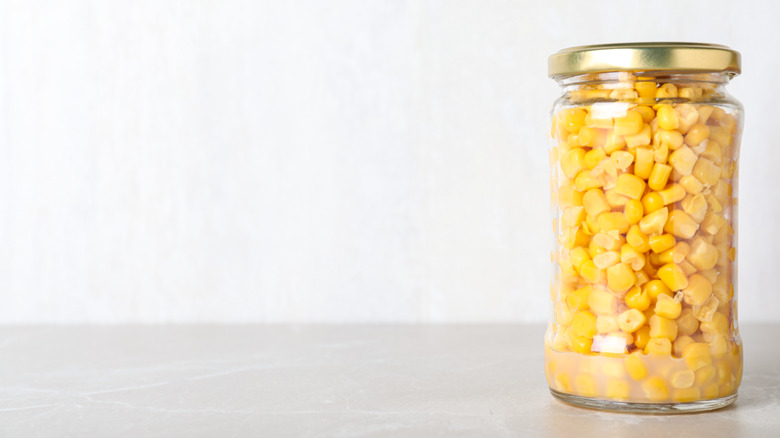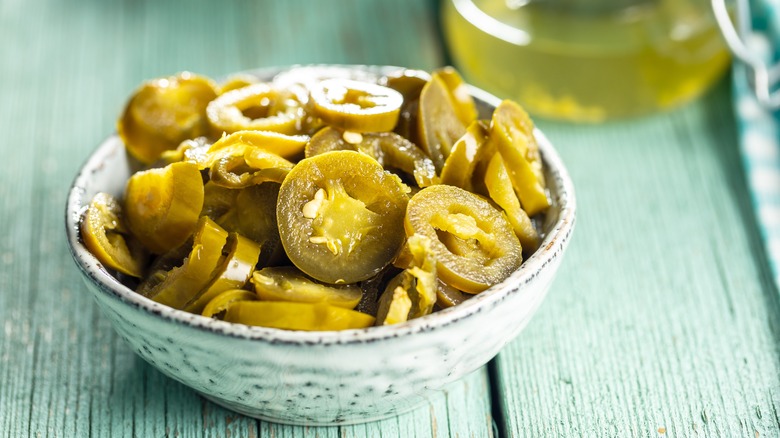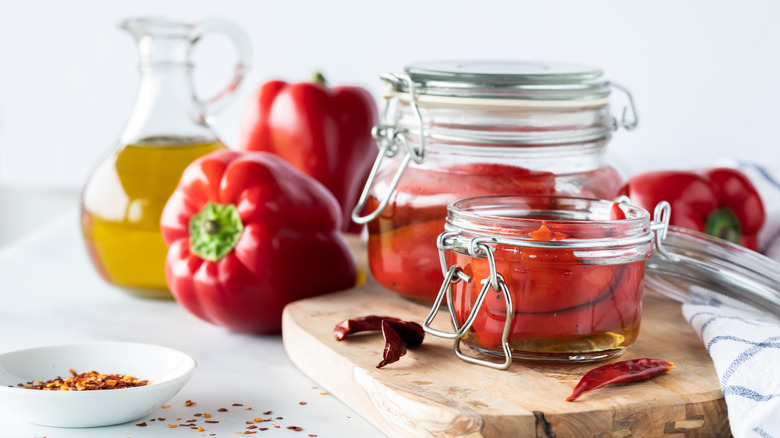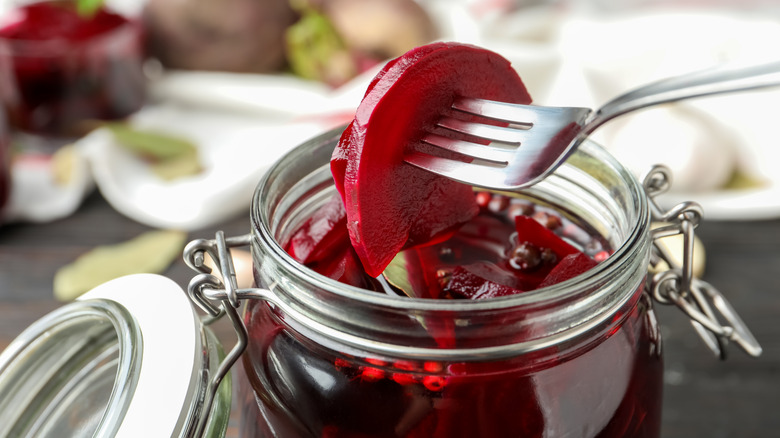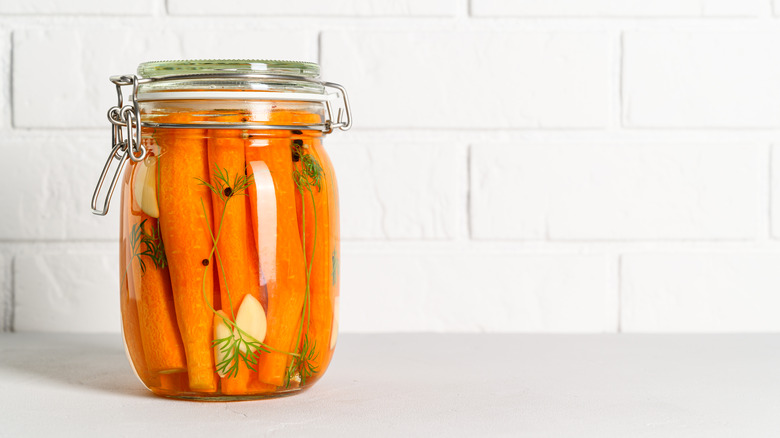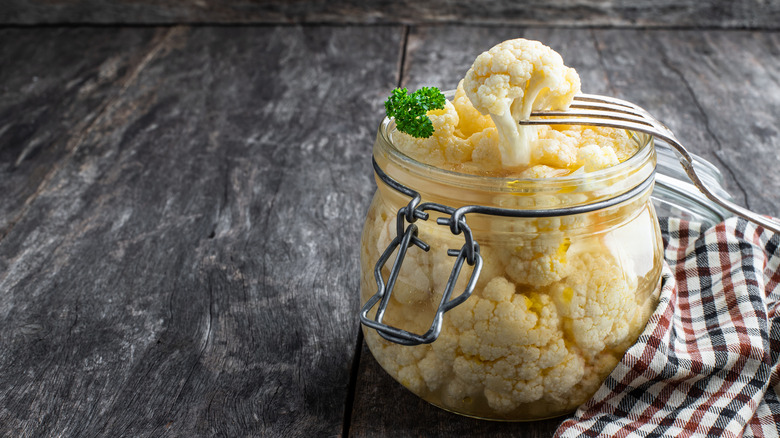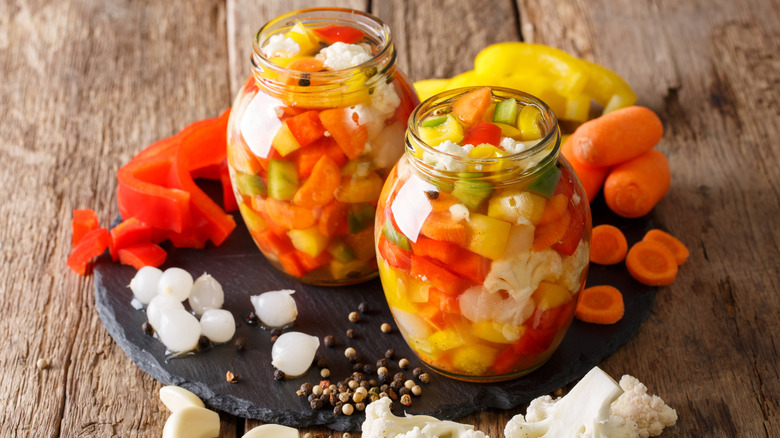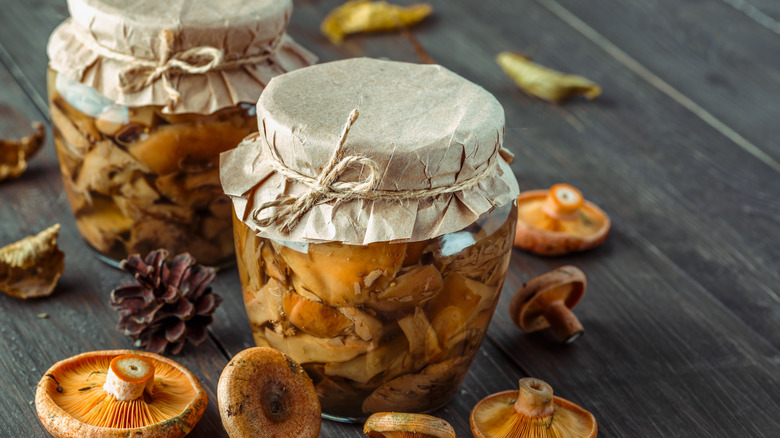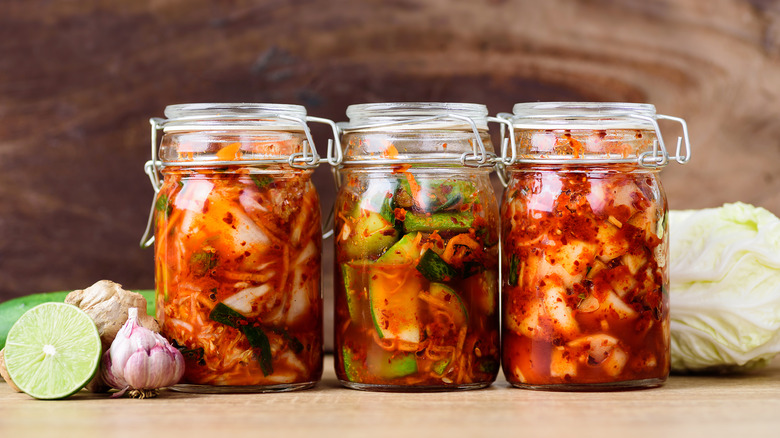14 Types Of Pickled Vegetables You Should Have In Your Fridge
Pickles are most commonly known in the form of brined cucumbers, either whole, spears, slices, or chips, and enjoyed in a multitude of ways, but the world of pickles goes a whole lot deeper than that one single crop. The method of pickling, which just includes fermenting something in an acidic brine, can be done to pretty much any fruit or vegetable and is popular in most every culture's cuisine.
Pickles date all the way back to ancient Mesopotamia when brining would be done to cucumbers to extend their lifespan. The preservation method is not only simple and effective, but it can also be delicious and nutritious. According to Medical News Today, pickles act as a probiotic, which promotes the growth of healthy bacteria that aid in digestion and overall gut health. Not only can eating pickles improve gut health in the short term, but it can also even prevent stomach issues in the future.
Although pickles are widely synonymous with cucumbers in a difficult-to-open glass jar, the wide world of pickles is ripe for exploration. Pickling things yourself is inexpensive, quick, simple, and a great way to bring new flavors to your favorite dishes or just keep your gut health in check. Here are some ways you can get started.
Cucumbers
The classic cucumber pickle is a polarizing food unlike none other. People either love them or detest them, the majority of which favors the former. Wherever you fall on the pickle spectrum, a quality jar of pickles deserves a place in your refrigerator, but purchasing one at the supermarket really is money not well spent. All that's required to jarring some great pickles yourself are cucumbers, water, salt, and vinegar.
Any additions are really up to your preference. You can sweeten your pickle brine with sugar, add some fresh dill for that classic taste, or spices like garlic, coriander, and mustard seed. Another great convenience of jarring your own pickles is you can do so in any shape you like. You can jar them whole, slice them longways into spears, or thin slices for sandwiches and burgers. The juice inside your pickle jar can even be used to brine food such as buttermilk fried chicken or a pickle-flavored cocktail if that's your thing.
The best part is, the longer your pickles sit in the fridge, the better they will taste, so even if you don't snack on them routinely, they'll always be there when you or someone else wants them.
Garlic
Everyone loves garlic — it's a staple in just about every single cuisine and the foundation of countless delicious dishes. Pickling garlic brings the plant into a whole different realm, tasty enough to eat on its own.
Brining garlic cloves with the usual water, vinegar, and salt trifecta reduces the plant's recognizable punchiness and makes it more palatable. Normally, that punchiness is mellowed out by cooking it, but fermenting in brine does the trick as well and keeps your breath at bay after enjoying it. Plus, you can add whatever herbs or spices you like to the jar.
Pickled garlic can be enjoyed on its own, but it makes an excellent addition to a charcuterie or antipasto board, or salad. Pickled garlic can also just be used as a replacement for regular garlic. Pressing the brined cloves into dishes or mashed potatoes can add another layer of flavor to familiar dishes and bump them up a level.
Red onion
Just like pickling garlic, pickling onions helps round out their acidity and make them less harsh. However, because onions are already an acidic vegetable, using white vinegar in the brine won't do much to achieve this, so red wine or apple cider vinegar is best.
One way to make vibrant pickled onions is to cover sliced red onions with citrus juice, such as the juice of a lime, grapefruit, orange, or a combination of the three. The result will yield a wonderfully sharp flavor. This onion pickling method is the traditional method in the Yucatán peninsula, dating back to the ancient Mayans, and yields an intense, unparalleled pink color.
Pickled red onions are an essential topping for tacos and an excellent addition to salads. They are also quite popular in Mediterranean cuisine alongside foods like arugula, feta cheese, and lamb. Pickled red onions are also delicious enough to eat on their own as a palate cleanser to begin or end a meal. Regardless of how you use them, pickled red onions should be your next refrigerator staple.
Radish
Pickled radishes are a simple way to add some extra tang and flavor to what's already a versatile vegetable. The vinegar used for pickling radishes is largely up to preference, but white vinegar and apple cider are probably your best options. Pickled radishes go best with some garlic and tarragon, which infuses the vegetables with a spicy, anise flavor. The texture of pickled radish is also excellent, adding a crisp crunch to all types of food.
After your thinly sliced radishes have been fermented, the limits to how you use them are really up to your own imagination. They are a sharp, acidic topping for tacos, they are greatly shingled on your favorite sandwich, and they can even make a delicious, unique addition to a crudités platter. The brine you make to pickle your radishes is just as useful, as a small amount can go a long way in making a terrifically tart vinaigrette.
Corn
Corn on the cob in the summertime is simplistic bliss. It's easy to make, useful in a wide range of cuisines, and loved by everyone. With a jar of pickled corn, that enjoyment can be had in an even wider variety of ways and not only when the crop is in season.
Like all other vegetables on this list, how you choose to pickle corn is up to your preference, but peppers like jalapeños make for a great addition with their subtle heat and contrast to the corn sweetness. Pickled corn is a great topping for salads and tacos and can even be used as the main ingredient for a corn salad or relish. It's great on hot dogs and sausages, a side dish to anything off the grill, or a simple way to garnish a soup.
Once you've made your pickled corn, it'll last well past summertime, up to months after jarring. Key signs to check if your pickled corn, or any pickles for that matter, have gone bad are a change in color, smell, or an increase of air in the jar (via Taste of Home).
Jalapeños
Pickled jalapeños are yet another delicious fermented vegetable rich in versatility, simplicity, and flavor. Simply put, the taste of this pepper is a harmonious trinity of salty, sweet, and spicy. Although jalapeño peppers are on the lesser end of the heat spectrum of chiles, the punchy heat they do contain makes for a perfectly balanced pickle suitable for almost anything. The brine will help to mellow out the heat, but if your heat tolerance is on the weaker side, these will become sweeter the longer they soak in the brine.
Pickled jalapeños are delicious enough to eat on their own but also make a great topping to dishes like tacos, nachos, or as a filling in quesadillas. They can be chopped up and added to salsa or relish, or even on top of a sandwich or tossed in a salad. Wherever you use jalapeños, try using pickled jalapeños for triple the flavor.
Roasted red pepper
Roasted red peppers are probably not something you've thought of as pickles, but they are most certainly something you've enjoyed time and time again. Roasted red peppers are an antipasto staple and the ultimate topping to a deli sandwich. Plus, roasting your red peppers yourself is just as easy as turning on your stovetop, grill, or broiler. Charring the exterior of a red bell pepper stimulates its natural sweetness and turns its texture into a velvety softness.
After removing the charred skin and slicing it thinly, one extra step can take them to a whole other level and allow you to enjoy them for weeks. Jarring your roasted bell peppers in a mixture of vinegar, sugar, and salt is a super simple, absolutely delicious way to enjoy them and bring some extra flavor to whatever you plan on using them for. Of course, garlic is the obvious compliment for these, but fresh herbs like parsley or thyme make for a jar of pickled peppers worthy of a place on any dish.
Purple cabbage
Cabbage is usually a vegetable without much flavor and just used in things like a slaw to bring some crunch to whatever it occupies. With pickled cabbage, its flavor does not have to be overlooked. Instead, pickled cabbage stands up to whatever it is mixed or served with. Pickled cabbage brings a crunchy texture to cole slaw or tacos in addition to some tangy zestiness, according to Live, Eat, Learn.
Apple cider vinegar is probably your best option to help make the flavor pop even more, along with your favorite herbs or spices. The best thing about jarring your own pickled red cabbage is that the vegetable is very cost-efficient. Because it's best to shred the cabbage before jarring, you can get a whole lot of pickles out of just one, generally inexpensive head of cabbage. They'll be in your fridge for as long as you need them, ready to bring some extra life to whatever you plan to use them in.
Beets
You may not always think of beets right away as a valuable side dish, but this sustainable, nutritious, and rustic vegetable checks almost every box. Plus, beets pair well with just about every meat, a sharp cheese, and other vegetables. Beets can also work wonders for your health, improving your heart, brain, and gut health as an anti-inflammatory.
Pickling and jarring beets yourself is a great way to take this awesome vegetable to the next level and elongate its shelf life. The key to pickling beets at home is the type of vinegar you use. White, apple cider or red wine vinegar will do the trick, but using ume plum vinegar will yield the most tasty results. Ume plum vinegar is salty, fruity, and tart all at once. A little goes a long way, and this vinegar is fast acting, so there is no need to wait long before your beets are ready.
Carrots
This pickled carrots recipe comes from Kevin West, certified Master Food Preserver from the University of California Cooperative Extension. These spicy pickles are the perfect complement to tacos and can even be used as a substitute for bacon, especially on a sandwich. West got his inspiration to pickle carrots from the many tacos trucks and taquerias in Los Angeles, his hometown. Now, you can replicate them yourself and enjoy them whenever you want.
If spicy pickled carrots may not be for you, pickling the root vegetable simply with apple cider vinegar, water, and salt will yield a delicious result as well. Carrots are especially great to enjoy in the fall and winter, so adding some peppercorns, cinnamon sticks, whole cloves, or allspice can bring a festive taste to your pickled carrots that are perfect for the autumn season. Pickled carrots can be used on pretty much anything you like, including in salads, as a condiment, on a cheese board, or even as a unique, briny cocktail garnish.
Cauliflower
Cauliflower is another vegetable that may be considered bland and boring, but pickling it can help bring it to life. One way to do so is with a spice-forward brine using turmeric, a popular spice commonly used in Middle Eastern cuisine. This particular recipe also introduces citrus juice from a lemon as well as white wine vinegar, a sweeter, more flavorful acid choice. The combination of coriander, cinnamon, and mustard seed come together for an ultra-flavor-packed pickled vegetable at a low cost.
As a bonus, pickled cauliflower can also be combined with carrots in the same jar. This not only provides a more layered flavor and texture, but the opportunity also arises for a very colorful jar of pickles, as the orange carrots can be accompanied by white or even pink cauliflower. Even tri-color carrots are a fun option if available. Visual style points are often hard to come by in the pickling game, so be sure to take advantage of this rare opportunity!
Giardiniera
If you haven't heard of giardiniera, chances are you've tasted it before without knowing what it's called. Giardiniera is a mix of pickled vegetables commonly used as a condiment on Italian deli sandwiches. The word "giardiniera" actually means "from the garden" in Italian. The hot peppers are the main player here, and the sweet, spicy, briny relish is the perfect spread on a loaf of semolina bread before piling the meats and cheeses high. Lucky for us, giardiniera is super easy to make.
A classic giardiniera typically consists of onion, carrot, cauliflower, celery, garlic, and hot peppers. Along with the regular pickle brine combination, a seasoning of red pepper flake is what really contributes to the intense flavor and perfect amount of heat. One adapted recipe from Pasadena-based chef, Bruce Kalman, infuses the vinegar with some chiles beforehand, adding an extra oomf to the brine and finished product. If you're not sure if you've ever had giardiniera, ask for it on your sandwich the next time you get a sandwich. After you realize how delicious it is, go home and make some yourself.
Mushroom
The world of mushrooms is seemingly endless. There are actually millions of known mushroom species, and dozens readily available to the average grocery shopper. Pickling mushrooms are not only a great way to intensify this incredibly versatile fungi, but the option of which type of mushroom to pickle is also yours for trial and triumph.
Pickled mushrooms are an excellent topping to your favorite sandwich and even a unique, tangy addition to a steak. By themselves, mushrooms go great with red meat, so why not pickled mushrooms for an added layer of flavor? The same can be said for pasta. A creamy mushrooms sauce on pasta is to die for, so garnishing that pasta with some pickled mushrooms is certainly worth a try. Mushrooms are another item that is mostly loved, but sometimes not so much. If you are someone who loves mushrooms, pickled mushrooms are a must-try. If you are someone who does not, they may just help turn you into a mushroom lover.
Kimchi
Korean cuisine has seen a recent boost in popularity across the U.S., and there is no food more essential to the culture than kimchi. The combination of fermented vegetables, mainly consisting of cabbage and hot, intensely flavored red pepper flakes and aromatics, might be the most flavorful type of pickled vegetable in the world. However, kimchi is not limited to just the most common and traditional cabbage. The category of kimchi can basically be applied to any vegetable, other common ones being cucumber, radishes, and green onion.
Kimchi is fermented by covering a vegetable with a mixture of salt, gochujang (hot pepper paste), gochugaru (hot pepper flakes), and an array of spices. Kimchi is typically fermented over the course of months, even up to a year. You can most definitely ferment your own kimchi at home, even doing a sort of "quick-pickle" to save time. If you've never had kimchi before, however, find a Korean market near you and try some. There really is nothing like it, and enjoying some before or after a meal will do wonders for your gut health. Not to mention, kimchi is delicious in scrambled eggs or in savory Korean pancakes called kimchijeon.
